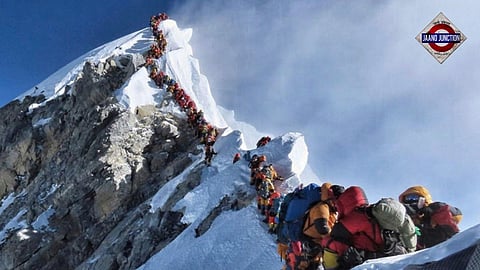

Inclement weather, steep peaks and mental battle - these are no longer the only challenges while scaling Mount Everest. Overcrowding on the world's tallest mountain, which has been an issue for years, and the stretch that mountaineers follow to ascend and descend, are back in focus after the 2024 season started off with a spate of deaths.
A British climber and his guide, a Kenyan banker and a Nepalese climber have died, and another guide remained missing as of Friday (May 24), following multiple incidents this week on Mount Everest, including an ice collapse at the mountain's dangerous zone.
British climber Daniel Paterson, 39, and his Nepali guide Pas Tenji Sherpa, 23, remain unaccounted for days after the ice collapse on Tuesday (May 21). The cornice dragged climbers down the side of the crowded mountain. Several videos circulated online showing overcrowding on the stretch en route to the peak of Mount Everest before the collapse happened.
Paterson and his Sherpa were with a 15-person group that had reached the Everest peak at 29,032 feet. Mount Everest adventure company '8K Expeditions', which organised the exploration, confirmed their inability to recover the duo in an Instagram post. It said that they were "caught in a sudden cornice fall which impacted the group of climbers".
The collapse happened on May 21 at 4.40 am (local time) near the Hillary Step, which saw a rush hour in the aftermath. The region, situated at more than 26,000 feet, is considered to be Everest's "death zone" because oxygen levels and air pressure can be fatal there over extended periods of time.
In a separate incident, Kenyan climber Joshua Cheruiyot Kirui, 40, was found dead and his 44-year-old guide Nawang Sherpa remains missing after they disappeared on the mountain on Wednesday (May 22).
Nepalese newspaper The Himalayan Times reported that Sherpa told the Everest base camp that Kirui showed "abnormal behaviour" and "refused to return and even consume bottled oxygen" before both vanished. Officials lost touch with the duo shortly thereafter. The Kenyan's close hiking friend told the BBC that Kirui died in a fall, and his body was discovered over 60 feet below Everest's peak.
These are not the only deaths that have plagued the Everest expedition. A Romanian climber was found dead in his tent on May 21 and two Mongolian climbers also died in the Hillary Step while descending, according to The Himalayan Times.
In the aftermath of a lethal week on Everest, several videos have surfaced on social media, showing overcrowding at the world's tallest mountain. A video showed the 'Yellow Band' area on the mountain lined by a long queue of climbers on Monday (May 20).
Another video showed climbers waiting in a queue, in an area which appeared to be the Hillary Step, to move forward before the deadly ice collapse happened.
The peak seasons for hiking up Mount Everest in Nepal are between March and May, and again from September to November, when the weather is moderate, according to the South China Morning Post.
Even then, snowstorms can strike without caution, axing communication and disrupting visibility. Then, there's the issue of mountain sickness, which can kick in much earlier than reaching the dangerous zones of Everest.
According to The Himalayan Database, avalanches have accounted for 40 per cent of deaths on Mount Everest in recent years. In 2016, an avalanche killed 16 people, in what is considered to be the worst accident on the mountain.
Despite the challenges, the sheer thrill of summitting the world's tallest mountain, has contributed to an increase in the number of travellers to the Himalayas. Citing the Nepal Tourism Board, the South China Morning Post reported that over 1.28 lakh tourists arrived in Nepal by air in March, accounting for a 28.9 per cent year-on-year surge.
Going with the trend, the past week has been busy on Everest. People have been taking to their social media accounts to flaunt their arrivals to the Everest base camp as they try to scale the mountain from Nepal. Though officials are yet to confirm the exact number, ExplorersWeb estimated that between 150 and 200 people scaled Mount Everest on May 19 and 20. The Himalayan Times reported that 100 people reached the top on May 19 alone. In fact, from May 19 and 22, several climbers and exploration operators posted their summit updates on social media.
In March, Kanchha Sherpa, 91, the only surviving member of the mountaineering expedition that first went to the top of Mount Everest, told The Guardian that the peak is now "too crowded and dirty" and the mountain is a God that should be protected.
"It would be better for the mountain to reduce the number of climbers," he said in an interview to The Guardian, and also pointed out the issue of climbers trashing the mountain with their leftovers and other hiking equipment.
He was one of the 35 members of the team that aided New Zealander Edmund Hillary and his Sherpa guide Tenzing Norgay to the top of the peak on May 29, 1953.
Expeditions to Mount Everest are a major source of income for Nepal, and the government is often criticised by Western climbers for allowing any individual who can pay an $11,000 fee for a permit to climb the mountain. According to a 2023 BBC report, the Nepalese government denied this. Furthermore, according to sherpas, each climber spends over $20,000 on an expedition to Nepal, including permit fees, food, guides, local travel and gas.
Last year in spring, Nepal issued a record 454 permits to scale Mount Everest, Al-Jazeera reported, citing officials.
A massive queue on Everest in 2019 forced teams to wait in freezing temperatures for hours to make the summit. The delay contributed to the decrease in oxygen levels of the climbers, resulting in their sickness and exhaustion. That year, at least four deaths were blamed on overcrowding, Al-Jazeera reported.
